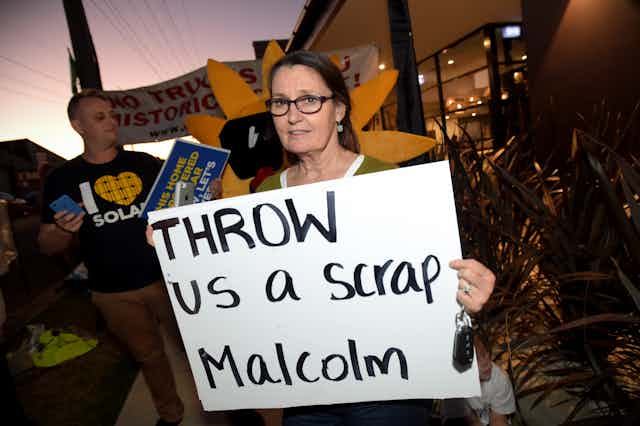Fairness, and which party is more committed to it, will be a big theme in the federal election. There has already been lots of argument about whether the May budget was fair, particularly in its changes to personal income tax. But as is so often the case, “fairness” depends on your perspective.
Treasurer Scott Morrison announced just one change to personal income tax in the Budget. From July, the $80,000 tax bracket will rise to $87,000. As a result, those earning over that amount will pay $315 less in tax each year. Those earning under $80,000 get no relief. In addition, the Temporary Budget Repair levy, which puts a 2% impost on personal income earned above $180,000, was not extended and will expire in June 2017.
Opposition Leader Bill Shorten thought these changes and non-changes to personal income tax were an unfair gift to the rich. In his Budget Reply, he said:
Was this really the point of the Turnbull experiment? Tax cuts for high income earners – and nothing for families. Not one cent for ordinary working Australians.
The Labor leader is right that fewer than a quarter of taxpayers will receive any tax relief from lifting the $80,000 threshold to $87,000. By definition they are the quarter of taxpayers who earn the highest incomes. And the expiry of the Temporary Budget Repair Levy only helps the 3% - 4% of taxpayers with taxable incomes above $180,000.
However, the picture is a little more complicated than Shorten makes out. To understand it requires a grasp of the phenomenon known as fiscal drag, commonly called bracket creep.
Fiscal drag occurs when wages increase at the rate of inflation or faster, but tax brackets don’t change. The extra wage is taxed at a worker’s marginal tax rate (the tax rate that applies to the highest tax bracket they are in), not at the worker’s average tax rate (the tax paid divided by their total income).
As a result, inflation results in the worker paying a growing share of their income in tax each year, even if their real income doesn’t rise. Like any increase in income tax, this reduces the incentives to work.
In 2013-14, an individual on the median income paid 13.1% of income in tax. By 2015-16, bracket creep had pushed the figure up to 14.5%.
Fiscal drag, while having no impact on the incomes of those remaining below the income tax free threshold, nevertheless tends to make the income tax system less progressive. That is because people on middle incomes suffer the fastest increase in the percentage of their income paid in tax.
Even a government with the best of intentions and flawless execution cannot reverse bracket creep perfectly. Income growth tends to be smooth, while the effect of fiscal drag can be sharp for those who move into the next tax bracket as a result of wage rises.
The chart below shows how fiscal drag affected taxpayers, measured in percentiles of income, between 2013-14 and 2016-17. It is based on the actual tax they paid in 2013-14 and projects forwards given inflation and the tax scales that will apply. It shows that fiscal drag most affected those just below the median income (at the 45th percentile). They paid almost 2% more of their incomes in tax. By contrast, someone earning $170,000 – in the top 4% of taxpayers – paid only an extra 0.8% of income in tax.
The chart also reveals that lifting the second highest tax bracket from $80,000 to $87,000 only helps the top 25% of taxpayers – and not those who have suffered most from fiscal drag over the last three years.

But this chart does not paint the full picture. While it shows the most recent data on individual tax distribution, it does not include the significant change to income tax policy built into the carbon tax legislation package. The package included tax cuts for low-income earners in 2012-13, and was retained even after the carbon tax was repealed.
If instead we take 2011-12 as our starting point, the picture is very different. Those in the bottom 30% of income earners are either paying no tax, or less tax on their income, than they paid before the 2011-12 change. Conversely, the top 20% of income earners have lost a greater percentage of their income than others. Moving the threshold from $80,000 to $87,000 largely balances out the relative losses they suffered in 2011-12.

So whether the latest Budget changes income tax in a fair way depends on your time frame. Over the short term, the Budget disproportionately helps those on high incomes. But in the context of other changes to income tax over a longer time-frame, the Budget does a reasonable job of distributing fiscal drag equally among taxpayers.
The graphs in this story have been updated since first publication so that the temporary budget repair levy is consistently included in all calculations.

